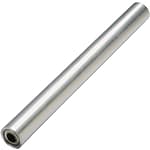(!)NOTE : Windows 7 users won’t be able to use some latest features of eCatalog/WOS since Microsoft is ending support for Windows 7 on 14 Jan, 2020. Please upgrade your system for uninterrupted services.
- Notice of End of Sales for Economy Series Pneumatic Equipment Category. More information.
MISUMI Rollers(Length:~1000)
MISUMI offers products Rollers specified by Length ~1000 from Automation Components product category. There are a total of 1 items. Search and select detailed specifications of parts for your machine with free CAD downloads. MISUMI products are available to order through MISUMI online 24 hours a day. Free shipping, no minimum order.
|
Mounting Method
|
|
|---|---|
Brand |
|
| CAD |
|
| Days to Ship |
|
1 items
- Sort By
-
You can add up to 6 items per a category to the compare list.



MISUMI
Rollers excellent in O.D. tolerance and geometric tolerance. Please use them for conveyance requiring high accuracy.
Mounting Method O.D.(mm) Roller Type Material Roller Shape Inner Dia. d(mm) Length(mm) Urethane Rubber Processing Straight 50 ~ 80 Metal Roller Aluminum Straight 12 ~ 35 ~1000 - Days to Ship: 10 Day(s) or more  10 Day(s) or more
10 Day(s) or more
| Brand |
|---|
| Product Series |
| CAD |
| From |
| Days to Ship |
| Mounting Method |
| O.D.(mm) |
| Roller Type |
| Material |
| Roller Shape |
| Inner Dia. d(mm) |
| Length(mm) |
| Urethane Rubber Processing |
You can add up to 6 items per a category to the compare list. | |
| Brand | MISUMI |
| Product Series | |
| CAD |
|
| From | - |
| Days to Ship | 10 Day(s) or more |
| Mounting Method | Straight |
| O.D.(mm) | 50 ~ 80 |
| Roller Type | Metal Roller |
| Material | Aluminum |
| Roller Shape | Straight |
| Inner Dia. d(mm) | 12 ~ 35 |
| Length(mm) | ~1000 |
| Urethane Rubber Processing | - |
Loading...
Configure
Specification/Dimensions
-
O.D.(mm)
-
Roller Type
- Urethane/Rubber Roller
- Metal Roller
- Plastic Roller
- Adjusting Components
-
Material
- Steel
- Aluminum
- Stainless Steel
- Urethane
- Plastic
-
Roller Shape
-
 Straight
Straight -
 Crowned
Crowned -
 Groove
Groove -
 Knurled
Knurled
-
-
Inner Dia. d(mm)
-
Length(mm)
- ~50
- ~100
- ~300
- ~500
- ~1000
-
Urethane Rubber Processing
Narrow search by specifying Manufacturer
Related Categories to Rollers
FAQ Rollers
- Question: What are conveyor rollers?
- Answer: Conveyor rollers are cylindrical components that allow materials to move smoothly along a conveyor system. They reduce friction and facilitate the movement of items on the conveyor belt or system.
- Question: What are the different types of conveyor rollers?
- Answer: There are several types of conveyor rollers, including: • Straight rollers: Used for straight conveyor sections. • Return rollers: Used on the bottom side of the conveyor belt to support it as it returns to the head pulley. • Idlers: Used in combination with rollers to support the conveyor belt and provide tension. • Gravity rollers: Used in non-powered conveyor systems, rely on gravity for movement. • Motorized rollers: Contain an internal motor to drive conveyor movement. • Driven rollers: Powered by external motors and belts. • Tapered rollers: Used for curves in conveyor systems to help with directional changes.
- Question: What is the purpose of conveyor rollers in material handling?
- Answer: Conveyor rollers facilitate the movement of products, packages, or materials from one place to another. They are used in manufacturing, distribution, and packaging industries to reduce manual labor, increase efficiency, and streamline processes.
- Question: How do I choose the right conveyor rollers for my system?
- Answer: To choose the right rollers, consider: • The type of material or product being conveyed. • The load capacity required. • The speed at which the conveyor will operate. • The operating environment (e.g., temperature, humidity, and chemical exposure). • The type of conveyor system (gravity, powered, etc.).
- Question: How do you maintain conveyor rollers?
- Answer: Proper maintenance includes: • Regular cleaning to prevent dirt and debris buildup. • Checking and lubricating bearings to ensure smooth movement. • Inspecting rollers for wear, damage, or misalignment. • Replacing worn-out rollers to avoid disruptions in the system.

















How can we improve?
How can we improve?
Thank you for your time.
Your feedback is essential for our continuous improvement
Privacy Policy
Thank you for your cooperation.
Thank you for your time.
Your feedback is essential for our continuous improvement
Please use the inquiry form.
Privacy Policy